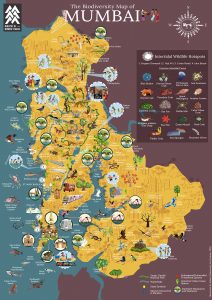Award-winning Indian Cartoonist Rohan Chakravarty has created biodiversity maps of regions across the planet. His exuberant illustrations show wildlife existing and even thriving against all odds.
A Visit to Tiger’s Nest
This map of Bhutan is unlike any other. Not only does it give the viewer a sense of the diversity in this tranquil mountain nation, it even references mythical creatures and totems that are of great cultural importance in Bhutan. Chakravarty sees this map as a representation of Bhutan’s biodiversity as well as representative of the Bhutanese lifestyle, including means of livelihood and its traditional architecture and the nation’s endangered fauna. It was commissioned by WWF Bhutan.
Hope and Fear in the Pearl River Delta
One of the most polluted and highly trafficked sea routes in the world is also a stronghold for species such as the Chinese white dolphin, the Romer’s tree frog, the Hong Kong newt, and many invertebrates. Chakravarty drew this map for WWF Hong Kong as a means to generate awareness about the declining wildlife in the Pearl River Delta and the urgent need for the conservation of country parks in Hong Kong. The map emphasises the need for cultural preservation in Hong Kong and the interconnectedness of tradition and ecology, for example in the Tai O Fishing Village and in the forests around the Tian Tan Budhha in Lantau Island.
The Sacred Landscape of Kailash
Stretching across India, Nepal and Tibet, this important pilgrimage destination is home to five religions: Hinduism, Buddhism, Bon, Sikhism and Jainism; has a geographically complex terrain: high altitude scrub, montane forest, montane grassland, alpine and evergreen forests etc; and a huge range of flora and fauna. To underscore its importance as a trekking destination, Chakravarty has included famous mountain peaks of the region including Mt. Kailash, Mt. Api and Om Parvat as well as important religious routes and sites in the map. It was commissioned by the International Centre for Integrated Mountain Development (ICIMOD).
Wildlife in the Maximum City
Flamingos in wetlands, mangroves sheltering the coastline, weird scorpions in the shrubbery and intertidal spaces rich in marine life – Chakravarty’s map of Mumbai, commissioned by international climate network Purpose Climate Lab, showcases its wild side. Look at the map and you’ll realise that even the most crowded hotspots in the city are home to a host of creatures, including Indian Ocean humpback dolphins, porpoises, olive ridley sea turtles and more. “Usually when one thinks of Mumbai, the image of a concrete jungle comes to mind,” says Chakravarty. “Ever since we’ve shared this map on the social media, so many people have reacted with such wonder when they have realised that this busy, bustling metropolis still has such a fabulous array of wildlife!”
Author: Geetanjali Krishna, The India Story Agency for Sacred Groves
Did you enjoy this article?
Share with friends to inspire positive action.

















